Replaces
2005 GMC Sierra 2500 HD Rear Semi-Metallic Brake Pads TRQ BFA73589
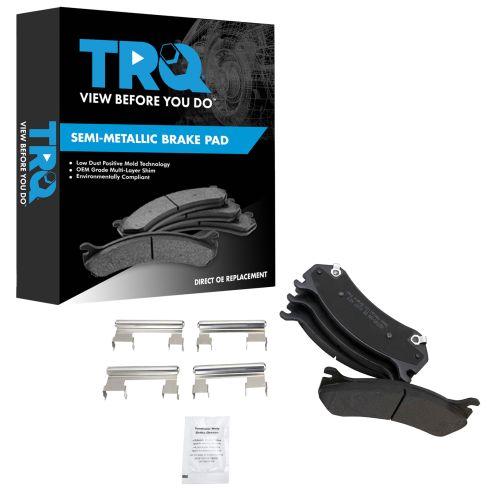


BFA73589
In Stock
This part doesn’t fit a . Select from parts that fit.
Specify your vehicle's year, make and model to guarantee fit.
Orders must be placed by 2pm ET
Get the kit
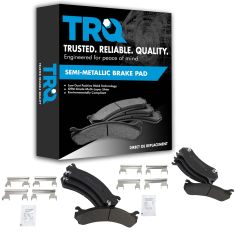
Semi-Metallic Brake Pads
$74.95
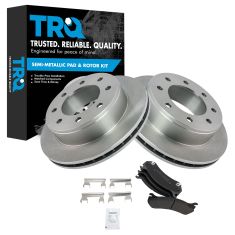
Brake Pad & Rotor Kit
$172.95
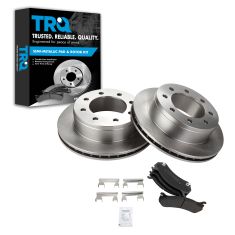
Semi-Metallic Brake Pad & Rotor Kit
$175.95
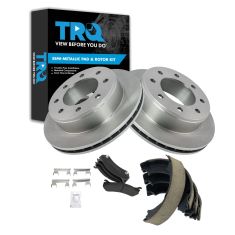
Semi-Metallic 4 Piece Brake Pad & Rotor Kit
$175.95
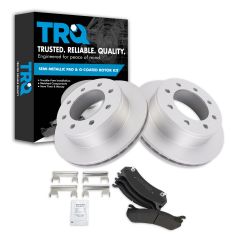
Semi-Metallic Brake Pad & Rotor Kit
$181.95
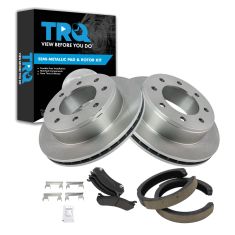
Semi-Metallic 4 Piece Brake Pad & Rotor Kit
$181.95
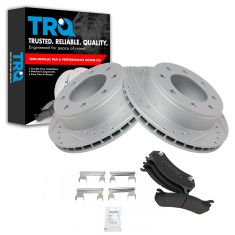
Semi-Metallic Performance Brake Pad & Rotor Kit
$186.95
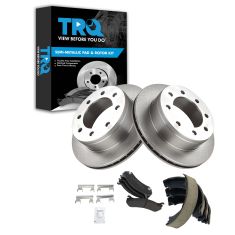
Semi-Metallic Brake Pad & Rotor Kit with Parking Shoes
$191.95

Semi-Metallic Performance Brake Pad & Rotor Kit
$196.95
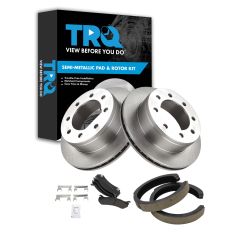
Semi-Metallic 4 Piece Brake Pad & Rotor Kit
$203.95
Part Details
- Brake Pad Bonding Type: Premium Posi
-
Includes:
Contact Point Grease
Hardware - Brake Pad Friction Material: Semi-Metallic
Specification
- Rear
Product Features
TRQ brake pads are manufactured using premium raw materials and design standards to restore original performance. TRQ brake pads are positive molded and utilize a multi-layer shim for enhanced performance and service life. TRQ’s combination of materials and design ensures a low dust and low noise braking experience. TRQ recommends replacing your brake rotors when you replace your brake pads to ensure even wear of components and improved braking comfort. All products are fit and road-tested in our Massachusetts R&D facility to ensure we deliver on our promise of Trusted Reliable Quality.
Item Condition:
New
Attention California Customers:
![]() WARNING: This product can expose you to chemicals including Lead and Lead Compounds, which are known to the State of California to cause cancer, and birth defects or other reproductive harm. For more information, go to www.P65Warnings.ca.gov.
WARNING: This product can expose you to chemicals including Lead and Lead Compounds, which are known to the State of California to cause cancer, and birth defects or other reproductive harm. For more information, go to www.P65Warnings.ca.gov.
Lifetime Warranty
This item is backed by our limited lifetime warranty. In the event that this item should fail due to manufacturing defects during intended use, we will replace the part free of charge. This warranty covers the cost of the part only.
FREE Shipping is standard on Orders shipped to the lower 48 States (Contiguous United States). Standard shipping charges apply to Hawaii, Alaska and US Territories. Shipping is not available to Canada.
Expedited is available on checkout to the United States, excluding Alaska, Hawaii and US Territories as well as P.O. Boxes and APO/FPO/DPO addresses. Final shipping costs are available at checkout.






Created on:
Tools used
- Loosen the 22mm caps on the hubcap with the vehicle on the ground Pull the hubcap free Raise the vehicle with a floor jack Secure the vehicle on jack stands Remove the lug nuts Pull off the wheel
- Turn the rotor by hand or turn the steering wheel to turn the rotor Check the thickness of the brake pads Check the brake pad wear indicator Check for gouges on both sides of the rotor
- Remove T55 Torx bolts from the brake caliper with a T55 Torx bit and ratchet Use either a C-clamp to squeeze the rotor or a screwdriver to pry the brake caliper off Pry the brake pads off with a flat blade screwdriver
- Apply brake grease to either side of your brake pads Push the brake pads into place, using a hammer if necessary Using an old brake pad put it on to the caliper pistons and tighten it in with the C-Clamp Grease up the caliper bolts
- Put the caliper back into place Slide the slide bolts back in Tighten the slide bolts to 30 ft/lbs
- Slide the wheel into place Start the lug nuts by hand Tighten the lug nuts preliminarily Lower the vehicle to the ground Tighten the lug nuts to 100 ft/lbs in a crossing or star pattern Reattach the hubcap and tighten the caps
- Pump your brakes repeatedly until they feel firm Test your brakes at 5 miles per hour and then 10 miles per hour Road test the vehicle
Brought to you by 1AAuto.com, your source for quality replacement parts and the best service on the Internet.
Hi, I'm Don from 1A Auto. I hope this how-to video helps you out, and the next time you need a part for your vehicle, think of 1AAuto.com. Thanks.
In this video, we're going to show you how to replace the brake pads on this 2002 Chevy Suburban. The items you'll need for this include new brake pads from 1AAuto.com, a 22mm socket and ratchet with a piece of pipe for extra leverage, a T55 Torx bit, a large C-clamp, a torque wrench, jack and jack stands, and brake grease.
You want to just loosen up these 22mm caps, and then pull the hubcap free. Then you want to loosen these lug nuts while the vehicle's on the ground, then raise the vehicle and remove them the rest of the way, unless you have air powered tools, then you can do it while it's in the air, and then just remove the wheel. Check your rotors. If there's any deep grooves or rust you'll want to replace the rotors as well. You can also check your pad life. You can see ours are actually in good shape, but we're going to show you how to replace them anyways.
There's two T55 Torx bolts that you need to remove. We'll fast forward as we use a T55 Torx bit and a ratchet to remove those. Then, using a large C-clamp, just put it back behind the caliper here, and the other part right here on the brake pad, and just twist this in. This is going to push your caliper piston in and make it easier to pull the caliper off. Just remove the C-clamp and lift your caliper up and off and set it aside. Using a flat blade screwdriver, just pry out your brake pad. Sometimes the brake pads can be stuck in there. Use a flat blade screwdriver and a hammer to pry it free. Apply brake grease to the tabs on either side of your brake pads.
Push your new brake pads into place and use a hammer if necessary to lightly tap that into place. Using an old brake pad, just put it onto the caliper pistons and then tighten it in with your C-clamp, and this will just push those pistons in the rest of the way. Grease up your caliper bolts, put the caliper back into place, and slide those slide bolts back in. We'll just fast forward as Don tightens those up. You want to tighten these to about 30 foot-pounds. Now, replace your wheel and then replace those lug nuts and tighten them preliminarily. Lower the vehicle and tighten them the rest of the way. Now, torque the lug nuts in a crossing pattern to 100 foot-pounds. Replace the hub cap and tighten up those caps. After doing work on your brakes, you'll want to pump the brake pedal until it firms up and then try a stop test from five miles per hour and ten miles per hour, then you're all set.
We hope this video helps you out. Brought to you by www.1AAuto.com, your source for quality replacement parts and the best service on the Internet. Please feel free to call us toll-free, 888-844-3393. We're the company that's here for you on the Internet and in person.
Tools used
- Loosen the lug nut covers by hand Pry off the center cap with a flat blade screwdriver Loosen the lug nuts with the vehicle on the ground Raise the vehicle with a floor jack Secure the vehicle on jack stands Remove the lug nuts Pull off the wheel
- Check for gouges on both sides of the rotor Check the thickness of the brake pads
- Pry the brake pads into the caliper with a flat blade screwdriver to push in the pistons Remove the two 18mm bolts from the brake caliper Pull the caliper aside Pry the brake pads off with a flat blade screwdriver Put an old pad in the caliper Use a large C-clamp and the old pad to push the pistons back Clean the caliper slide bolts Apply bearing grease to the slide bolts
- Pry the clips off the brake rotor Apply rust penetrant to the lugs Tap the rotor with a hammer to loosen it Pull the rotor off If necessary, pry out the emergency brake adjuster plug with a flat blade screwdriver If necessary, adjust the emergency brake with a brake spoon or flat blade screwdriver Clean the emergency brake shoes with mineral spirits Apply anti-seize grease to the brake backing plate
- Slide the rotor on Thread on one lug nut to hold the rotor in place Adjust the emergency brake, if necessary Push on the emergency brake adjuster plug
- Clean the caliper bracket with a wire brush Put the bracket onto the caliper Push the brake pads into the caliper Put the caliper and bracket into place Start the bolts by hand Tighten the bolts to 120 foot-pounds of torque
- Remove the place holder lug nuts Slide the wheel into place Start the lug nuts by hand Tighten the lug nuts preliminarily Lower the vehicle to the ground Tighten the lug nuts to 110 foot-pounds in a crossing or star pattern Reattach the center cap Tighten the lug nut covers with a 22mm socket
- Pump your brakes repeatedly until they feel firm Test your brakes at 5 miles per hour and then 10 miles per hour Road test the vehicle
Brought to you by 1AAuto.com, your source for quality replacement parts and the best service on the Internet.
Hi, I'm Mike Green. I'm one of the owners of 1A Auto. I want to help you save time and money repairing or maintaining your vehicle. I'm going to use my 20-plus years experience restoring and repairing cars and trucks like this to show you the correct way to install parts from 1AAuto.com. The right parts installed correctly: that's going to save you time and money. Thank you and enjoy the video.
In this video we are going to be showing you how to replace the rear brakes on this 2002 GMC 2500 HD, same as a Chevy as well, same as 2000 to 2007 both GMC and Chevy 2500 HDs. Tools you will need are 18 and 22mm sockets with your ratchet, and a breaker bar and pipe for more leverage. I also do show you a way to get leverage with an 18mm wrench and an additional wrench to hook to it, large regular screwdriver or small pry bar, a large hammer, small and small stubby regular screwdrivers, also a brake spoon for that part of the video would work, wire brush, bearing grease, small hammer and of course jack and jack stands.
Start out by removing your wheel. Carefully remove the plastic retainers and your center cap and then if you are working with hand tools you want to start with the vehicle on the ground, loosen the lug nuts, then raise it up and secure it, and then remove the lug nuts. I have the benefit of air tools here, so I removed the lug nuts and removed the tire.
So taking a closer look at our brakes, you can see our discs are really deteriorating here, so we are going to replace those, and you can see right in there, that pad, we had a little bit of life left and the other one looks like it's got more, but obviously we are going to replace the pads as well.
So to remove the calipers, here, what we are going to do is we are going to undo this 18mm bolt here and then the same one down here, an 18mm bolt. These are Torx screws, but this top one is very difficult to get to, so what we are going to do is we are going to take the bolts off and remove the whole caliper bracket and everything first. Before you unbolt it, what you can do is take a large screwdriver. I have a breaker bar here. Feed it right into this hole here and pry out and that forces the pistons back into the caliper. There is somewhat limited room here, so I put my 18mm wrench on there, take another wrench which gives me a little extra leverage, and if you have a breaker bar and a socket available then you can usually fit those in there as well. I am just showing you this as an alternative method. I can remove this bolt and it comes right off. The lower one is easier to get to so you can use the ratchet or breaker bar, or anything, or air tools. I will finish getting this out and you can bring the caliper up like that. I am going to fast forward here. Basically once you pull that bracket up, you just have to force the shoes down through the bracket and the biggest thing is there are little wear tabs that will get caught and you just make sure you bend those wear tabs in and the shoes will go down right through the bracket and you can pull the bracket right off.
Now, what we have here is we got our caliper. I got a big C-clamp and one of the old pads, so I am going to work this caliper with the C-clamp and push those pistons back in and I am going to wipe down these slide bolts. They look like they are in nice shape. Clean up the sticky stuff on them. Put on a little bit of new bearing grease. Make sure they're moving well.
Now I move this caliper, it's got a couple little locks to hold it on. You can either break these off or twist them off. They come off easily enough. Now I am just going to coat this with some penetrating oil. I already know my rotor is in tough shape, so I am not going to worry too much about hurting it, when I get them off. It actually came off really easily. You can hit it right back here where your caliper was and I have open space.
You saw my rotor come off really easy, but that is not always going to be the case. Sometimes your emergency brake might be adjusted so that the rotor doesn't come off very easily, so the first thing you might want to do is to have a short screwdriver, so I am talking with the rotor still on, you reach back here and you can see I am pulling that plug out. What you are going to want do is take another screwdriver or a little bit larger, but still a small screwdriver and go through the back side until you feel this wheel and then you are going to turn the wheel star down, which is bringing the screwdriver up, and that will basically loosen your emergency brake so your rotor will come off easier. So I have used some mineral spirits, and I've cleaned off my shoes for my emergency brake and I see that I got some oil on there and that probably means I've got bad axle seal, but this truck got 240,000 miles on it, so I am not that worried about it. I am going to use some anti-seize here. I'm probably never going to have to get this off again, but if I do have to get it off again now I know I can.
The new rotor from 1A Auto is in a lot better shape than the old one. It goes right on. I lightly secure with a couple of lug nuts and now I am going to take my small screwdriver, go in to the backside and tighten up the emergency brake adjuster, basically until I start feeling it give some friction to the wheel. I am going to fast forward through this. You do want to go on this side with the handle of your screwdriver up and then move it down, which moves the wheel up inside the rotor and it is kind of trial and error. Sometimes you can move it one way and you don't tighten it and then move it the other way and you do tighten it. It takes a little longer, but adjust them until you have good friction from the shoes and then make sure you replace that rubber dust plug.
Here is my bracket for my brake shoes and what I am going to do is just take these stainless steel slides with a wire brush on them and clean them all up. Get all this dirt off of them. Here are new pads from 1A Auto. You can see a little bit more life then the old pads that were on there. So we got our caliper with slide bolts cleaned and well-greased. This can be the problem with these trucks if these dry out and get dirt in them or whatever, the calipers actually seize up and your rear brakes do not even work, so if that the case you may want to replace these slide bolts, but you definitely want to get them out, clean them up and if you have to wire brush them and make sure you get a good amount of grease back on them. I've got my shoes right there. What I am going to do is take my bracket and just put a little tiny bit of that penetrating oil and that is not really going to make it slide, it is just to make it easier to get together. Put my brackets down on to the slide bolts, then into the shoes. Use a small hammer and looking at these carefully, make sure that the wear tabs go through correctly and also that your shoes are in the right spot here. It's just out there. Okay, that shoe is on. It may benefit you to take like a screwdriver or pry bar and just kind of, the shoe is getting stuck here on this slide a little bit. Push it into place and then lower it, and it looks like it could go in a little bit, push them into place a little bit and then it goes down on. You might have to shake it around a little bit before it goes in towards that bolt. Do the same down here. Get the lower bolt started and take out my lower bolt a little bit with the air wrench. I cannot really get a torque wrench down here, so I am going to just put my wrench back on here and tighten this up really good and it should be tightened to about 120 foot-pounds. We will use a torque wrench.
I am going to speed it up here as I remove those two lug nuts, then put the wheel on, hand thread my lug nuts at first, then use my air wrench just to tighten them up a little bit. Very important: you want to make sure before you test drive the vehicle you pump the brakes a bunch of times then make sure it stops from like five miles an hour and ten miles an hour before you road test.
Here again, fast forward as I have now put the vehicle on the ground and I am torquing the lug nuts to 120 foot-pounds using a crossing pattern and then I actually go around one-by-one afterwards just to check and make sure that they are all torqued, and then put your cap on and hand tighten the plastic retainers.
We hope this video helps you out. Brought to you by www.1AAuto.com, your source for quality replacement parts and the best service on the Internet. Please feel free to call us toll-free, 888-844-3393. We're the company that's here for you on the Internet and in person.
Tools used
- Remove hub cap or center cap if you have it, using a 21mm socket if needed. While your car is still on the ground, use your 22mm socket to loosen your lug nuts. Jack up and secure your car with jack stands. Remove the lug nuts with your 22mm socket and ratchet. Remove the wheel and set aside.
- Use a screwdriver to force the pistons back in. Remove the two 18mm bolts to remove the calipers. Use a wire tie to fasten the caliper out of the way. Use your screwdriver to pry out your brake pads. Remove the two 21mm bolts on the caliper bracket to remove it. Remove the caliper bolt sleeves. Check their condition and clean them with a wire brush if necessary. Screw in the two 10M bolts into the rotor till it pulls it off. Pull off the brake rotor. Hit the rotor with a rubber mallet or hammer if necessary. Take care not to damage the lug studs.
- Clean new rotor with brake cleaner. Clean hub with a wire brush. Use a little anti-seize to keep the rotor from seizing to the hub. Insert your new pads into the brackets. Put your caliper bracket back on, and tighten the bolts to 120 ft lbs. Compress the caliper piston with a c-clamp and block of wood to reset the pistons. Mount the caliper on the bracket and torque the bolts in to 90 ft lbs. Use a little anti-seize to keep the rotor from seizing to the hub.
- Use a little anti-seize to keep the wheel from seizing to the rotor. Make sure to use a star pattern when putting your wheel lugs back on. Tighten to 120 ft lbs. Replace hubcap/center cap.
- Before driving the car again, start it up and pump the brakes a few times to get the pistons in the brakes in place. Test the brakes in your driveway before taking the car onto the road. Set your rotors by evenly braking from 30mph to 10mph, 50mph-30mph and finally 70mph to 40mph. This is best done on a straight back road without any traffic.
Brought to you by 1AAuto.com your source for quality replacement parts and best service on the internet.
Hi, I'm Mike Green. I'm one of the owners at 1AAuto. I want to help you save time and money repairing or maintaining your vehicle. I'm going to use my 20+ years experience restoring and repairing cars and trucks like this to show you the correct way to install parts from 1AAuto.com. The right part installed correctly that's going to save you time and money. Thank you and enjoy the video.
In this video we're going to show you how to change the front brakes on this 2002 GMC 2500 HD, pretty much the same as any 2000-2006 and even some '07, the 2500HD as well as the 2500 both GMC as well as Chevy Silverado. Tools you'll need are: A jack and jack stands, various millimeter sockets with a ratchet, an extension, a breaker bar or metal pipe for some leverage if you don't have impact tools like I have in the video, penetrating oil, a large screwdriver or pry bar, a wire brush, two 10 m x 70 mm long standard thread bolts, anti seize lubricant, and a large C-clamp and a piece of wood.
Okay, so you'll want to remove your caps 21 mm, do this carefully. Okay, we'll fast forward a little bit and we'll use fast forward quite a bit for these monotonous parts. If you don't have air tools you'll want to loosen the lug nuts with the tire on the ground, then jack up and support with jack stands under your vehicle. We're using a 22 mm. Okay, and we'll fast forward here again as we remove the rest of the lug nuts and remove the tire from your vehicle. You can see here I go to the other side and just turn the wheel, you can also just use your steering wheel, this allows you access to the back easier. Okay, so you want to inspect your brakes and you can see the face of this rotor is nice and smooth, if you run the back side of your fingernail up and down it, it looks pretty good. Then there's, you can actually see, probably, you can see right here when you move, you can see that moving part to the rotor, just to the left of it that's your brake pad, which it looks like there is pretty good life and this right here is your other brake pad and again, it looks like pretty good life. But, if you come down here and we look up in here and look at the surface of the rotor in here one, I can see some pitting which I don't like, and then there's a pretty good groove on this here so I'm going to remove the calipers and the rotors.
To remove the calipers I'm going to start with these two bolts here, okay, this bolt and this bolt. Okay, I want to remove the bracket to remove the rotor or the disk, I'm going to move this bolt and this bolt down here. I'm just going to take a big screwdriver, put right in here, and then slowly pry out. Okay, and that does two things it resets the pistons and also loosens it up so that the caliper comes right off.
The bolts are 18 mm, so a breaker bar is your best tool and if you only have a ratchet what you can do is take a piece of pipe and put it on the end and that gives you more leverage. Then you can pull and loosen those up. I do have air tools so I'm going to use them. Pull your pins out here and you'll want to clean these up and re-grease them. My lower one is not coming out very easily. Okay, that was pretty dry so we really need to clean that up and grease it well. It's okay to use the screwdriver to pry the caliper to come off. Then you'll want to set that here. Then your pads come off easy enough. If you were just changing your pads, we just pull off like that. Now the bolts that hold this bracket on are 21 mm. So what you'll probably want to do is spray a bunch of penetrating oil on there. Another thing that will help is if you take a screwdriver and you clean as much of the scale and stuff right here, okay, after you scrape that out coat back here with the penetrate as well. And I did show doing that to one spot, what you want to do is spin the rotor around and scrape all the scale for the entire diameter of the rotar and also coat the entire circumference of the rotor.
Is some M10 metric bolts; these are 7 cm long and just thread them in these two holes. I'm going to use my impact wrench, so you're basically just going to tighten them up so you pull the rotor and it comes off. Then take your bolts back out of the rotor. We can see on this rotor there is some definite pitting issues and we're going to replace it. With the rotor off, we want to clean off the hub. I used a screwdriver to scrape some of the scale off and then a wire brush to clean up more of the rust and then we're going to use some anti seize and put it on there. You can also use some, just some motor oil or penetrate to seal it.
Okay, so here's our new rotor from 1A Auto, the exact same as the old one and it has the threaded holes so it will come apart and I put a bunch of anti seize in the inside and put it on here. Give it good tap and then I like to put a couple of lug nuts on just makes it easy to get the brakes all together. Okay, now I'm going to take the brake parts cleaner, cut a paper towel, make sure there's no grease or anything still on the rotor. If you don't have brake part cleaner, household rubbing alcohol will do the same thing. Okay, so here's our caliper brackets, okay the stainless steel slides here take the wire brush and just clean those and polish them up nice, not polish them but just clean them off.
Now, here without 21 mm bolts we're bolting the bracket back on to the backside of the steering knuckle. Do keep in mind that the bracket goes on the rotor side so we'll start these bolts. Tighten these up to 120 foot pounds. These shoes have thin shins on them so you want to put a little coat of silicone lubricant on them and then you want these wear tabs to be facing against the way the wheel is going, you basically want them facing down. So, you put this on.
Okay, so you remember our slide bolt that was dry? Take a screwdriver and kind of get any of the scale off of it. This one is borderline needing to be replaced actually. Okay, a little grease on it, make sure it's greased up well. Okay, what I've got here is a piece of wood on both pistons and then a large C-clamp and as I tighten it's going to force the pistons back into the caliper. Tighten it as much as you can and get those pistons seated as far down there as you can and your clamp goes over the wood and then your caliper will go down right over, but you need to kind of move the little boot around a little bit, and then your bolt you cleaned up and lubricated. So, the caliper still moves back and forth we want a little bit more, I'm going to put these up to 90 foot pounds.
Okay, we're going to speed it up here, as I straighten the wheels, remove those two lug nuts, a little bit of anti seize or you could just put some oil or something just to keep the wheel from seizing to the disk. And now put the wheel on start your lug nuts by hand first, then I use my 22 mm impact wrench just to tighten them up preliminarily. Okay, now with the truck on the ground I'm going to torch my lug nuts to 120 foot pounds. I'm going to use a crossing pattern and then just another key while I'm doing this, before you drive your vehicle make sure you pump your brakes a whole bunch of times until the pedal feels nice and firm. That works the cylinders or the pistons back to the set position and then just make sure your brakes hold the vehicle in gear and then do a stop from 5 mph and a stop from 10 mph before you go out and road test your vehicle.
We hope this helps you out. Brought to you by www.1AAuto.com-- your source for quality replacement parts and the best service on the internet. Please feel free to call us toll free: 1-888-844-3393. We are the company that serves you on the internet and in person.
Tools used
- Loosen the lug nut covers with a 22mm socket Pry off the center cap with a flat blade screwdriver Loosen the lug nuts with the vehicle on the ground Raise the vehicle with a floor jack Secure the vehicle on jack stands Remove the lug nuts Pull off the wheel
- Check the thickness of the brake pads Check the brake pad wear indicator
- Remove T55 Torx bolts from the brake caliper with a T55 Torx bit and ratchet Use either a C-clamp to squeeze the rotor or a screwdriver to pry the brake caliper off Pry the brake pads off with a flat blade screwdriver Remove the two 18mm bolts from the caliper bracket Slide the rotor off
- Apply brake cleaner to either side of the rotor Apply brake grease to either end of your brake pads Use a wire brush to clean up the brake slides on the caliper bracket
- Push the rotor back into place Twist on a lug nut Put the caliper back into place and tighten the two 18mm bolts Torque the 18mm bolts to 75 ft/lbs Push the brake pads into place, using a hammer if necessary Using an old brake pad, put it on to the caliper pistons and tighten it in with the C-Clamp Grease up the caliper bolts Put the caliper back into place Slide the slide bolts back in Torque the bolts to 30 ft/lbs
- Slide the wheel into place Start the lug nuts by hand Tighten the lug nuts preliminarily Lower the vehicle to the ground Tighten the lug nuts to 100 ft/lbs in a crossing or star pattern Reattach the hubcap and tighten the caps
- Pump your brakes repeatedly until they feel firm Test your brakes at 5 miles per hour and then 10 miles per hour Road test the vehicle
Brought to you by 1AAuto.com, your source for quality replacement parts and the best service on the Internet.
Hi, I'm Don from 1A Auto. I hope this how-to video helps you out, and the next time you need a part for your vehicle, think of 1AAuto.com. Thanks.
In this video, we're going to show you how to replace the brakes on this 2002 Chevy Suburban. The items you'll need for this include a new brake pad and rotor kit from 1AAuto.com, an 18mm and 22mm socket and ratchet, a piece of pipe for extra leverage, a T55 Torx bit, a large C-clamp, a torque wrench, a wire brush, jack and jack stands, brake cleaner, and brake grease.
You want to just loosen up these 22mm caps, and then pull the hubcap free. Then you want to loosen these lug nuts while the vehicle's on the ground, then raise the vehicle and remove them the rest of the way, unless you have air powered tools, then you can do it while it's in the air, and then just remove the wheel. You want to check for any deep groves in your rotor. You want to check in here for the life of your brake pads and over here for the life of the other one. You can see ours is actually in decent shape.
There's two T55 Torx bolts that you need to remove. We'll fast forward as we use a T55 Torx bit and a ratchet to remove those. Then, using a large C-clamp, just put it back behind the caliper here, and the other part right here on the brake pad, and just twist this in. This is going to push your caliper piston in and make it easier to pull the caliper off. Just remove the C-clamp and lift your caliper up and off and set it aside. Using a flat blade screwdriver, just pry out your brake pad. Sometimes the brake pads can be stuck in there. Use a flat blade screwdriver and a hammer to pry it free. You want to remove these two 18mm bolts on your caliper bracket.
You can see we use a piece of pipe for some extra leverage, here. We'll just fast forward as he breaks the other one free and removes both of these bolts. Now, slide the rotor off. On the left is the old rotor and brake pads, on the right are the new ones from 1A Auto. You can see they're identical and they'll fit exactly the same.
Spray your new rotor with brake cleaner and just wipe it down. Do the same thing to the back. Now, apply brake grease to the tabs on either end of your brake pads. Using your wire brush, just clean up those brake slides on your caliper bracket. Push your rotor back into place and then twist on a lug nut. This will hold the rotor in place. Turn the wheel and put the caliper bracket back in to place. Replace those two 18mm bolts. We'll fast forward as Don does this and tightens both of those up. Torque both of these to 75 foot-pounds.
Push your new brake pads into place. Use a hammer if necessary to lightly tap that into place. Using an old brake pad, just put it onto the caliper pistons and then tighten it in with your C-clamp. This will just push those pistons in the rest of the way. Grease up your caliper bolts. Out the caliper back into place and slide those slide bolts back in. We'll just fast forward as Don tightens those up. You'll want to tighten these to about 30 foot-pounds.
Now, replace your wheel and then replace those lug nuts and tighten them preliminarily, lower the vehicle, and tighten them the rest of the way. Torque the lug nuts in a crossing pattern to 100 foot-pounds. Replace the hubcap and tighten up those caps. After doing work on your brakes, you want to pump the brake pedal until it firms up and then try a stop test from five miles per hour and ten miles per hour, and you're all set.
We hope this video helps you out. Brought to you by www.1AAuto.com, your source for quality replacement parts and the best service on the Internet. Please feel free to call us toll-free, 888-844-3393. We're the company that's here for you on the Internet and in person.
Tools used
- Loosen the lug nut covers with a 22mm socket Pull off the center cap Loosen the lug nuts with the vehicle on the ground Raise the vehicle with a floor jack Secure the vehicle on jack stands Remove the lug nuts Pull off the wheel
- Check for gouges on both sides of the rotor Check the thickness of the brake pads
- Remove the two 12mm bolts from the brake caliper Use a large C-clamp to press in the brake caliper piston Pull the caliper aside Pry the brake pads off with a flat blade screwdriver
- Apply brake grease to the tabs of the new brake pads Put an old pad in the caliper Use a large C-clamp and the old pad to push the pistons further back Install the new brake pads into the bracket Put the caliper on Thread the two 12mm bolts by hand Tighten bolts to 30 foot-pounds of torque
- Slide the wheel into place Start the lug nuts by hand Tighten the lug nuts preliminarily Lower the vehicle to the ground Tighten the lug nuts to 100 foot-pounds in a crossing or star pattern Reattach the center cap Tighten the lug nut covers
- Pump your brakes repeatedly until they feel firm Test your brakes at 5 miles per hour and then 10 miles per hour Road test the vehicle
Brought to you by 1AAuto.com, your source for quality replacement parts and the best service on the Internet.
Hi, I'm Don from 1A Auto. I hope this how-to video helps you out, and next time you need parts for your vehicle, think of 1AAuto.com. Thanks.
In this video, we're going to show you how to replace the rear brake pads on this 2002 Chevy Suburban. We show you on the passenger side, but the driver's side is the same procedure. The items you'll need are new brake pads from 1AAuto.com, 12 and 22 mm socket and ratchet, flat blade screwdriver, large C-clamp, torque wrench, and jack and jack stands.
Start off by loosening up these lug nut covers and we'll fast forward as Don does this. Once those are all loosened up, you can pull the hubcap free. Now, you want to loosen the lug nuts preliminarily, raise the vehicle, and remove them the rest of the way, unless you have air powered tools. Then, you can do it while it's up in the air.
To inspect your brakes, run your finger along the rotor, check for any deep grooves. You can look in here for the life of this brake pad, and then, through here for the life of the other brake pad.
Now, remove these two 12mm bolts and we'll fast forward as Don does that. Use a large C-clamp. You put it on this end on the back of the caliper and on this brake pad and just twist it in. This is going to push the caliper piston in and make it easier to pull the caliper up and off. Remove the large C-clamp, pull the caliper free, and set it aside. Pry out the brake pads.
Take your new brake pads and apply brake grease to the tabs on either end of the brake pads. You want to reset the pistons in your caliper so put an old brake pad in there and just twist the C-clamp and it'll push those pistons back in. Push your new brake pads into place, and then, put your caliper back down into place and replace those two 12 mm bolts. We'll fast forward as Don does this and tightens them up. You want to tighten these to about 30 foot-pounds.
Put your wheel back into place and then replace your lug nuts and tighten them preliminarily. We'll fast forward as Don does this. Lower the vehicle and torque the lug nuts to 100 foot-pounds in a crossing pattern. Replace that hubcap and tighten up each of your lug nut covers. Before taking the vehicle out on the road you want to pump the brake pedal until it firms up and then do a stopping test from 5 miles per hour and then 10 miles per hour and you're all set.
We hope this video helps you out. Brought to you by www.1AAuto.com, your source for quality replacement parts and the best service on the Internet. Please feel free to call us toll-free, 888-844-3393. We're the company that's here for you on the Internet and in person.
Tools used
- Loosen the lug nut covers with a 22mm socket Pry off the center cap with a flat blade screwdriver Loosen the lug nuts with the vehicle on the ground Raise the vehicle with a floor jack Secure the vehicle on jack stands Remove the lug nuts Pull off the wheel
- Remove the 18mm bolts from the brake caliper Pry the brake pads into the caliper with a flat blade screwdriver to push in the pistons Pull the caliper aside Pry the brake pads off with a flat blade screwdriver Remove the brake pad slides
- Spray the 21mm bolts with penetrating oil if rusted Remove the 21mm bolts from the brake caliper bracket Pull off the brake caliper bracket Pull the rotor off If the rotor will not come off, thread the lug nuts and strike the hub area of the rotor with the ball end of a ball peen hammer
- Clean the rotor with brake parts cleaner Clean the brake pad slides with a wire brush Apply grease to the caliper slides Apply grease to the brake pad tabs Clip the brake pad slides to the caliper bracket Put an old pad in the caliper Use a large C-clamp and the old pad to push the pistons back
- Slide the rotor on Thread on one lug nut to hold the rotor in place Put the bracket back into place Start the bolts by hand Tighten the bolts to 100 foot-pounds of torque
- Install the new brake pads into the bracket Put the caliper on Thread the bolts by hand Tighten the bolts to 100 foot-pounds
- Slide the wheel into place Start the lug nuts by hand Tighten the lug nuts preliminarily Lower the vehicle to the ground Tighten the lug nuts to 100 foot-pounds in a crossing or star pattern Reattach the center cap Tighten the lug nut covers with a 22mm socket
- Pump your brakes repeatedly until they feel firm Test your brakes at 5 miles per hour and then 10 miles per hour Road test the vehicle
Brought to you by 1AAuto.com, your source for quality replacement parts and the best service on the Internet.
Hi, I'm Mike from 1A Auto. I hope this how-to video helps you out, and next time you need parts for your vehicle, think of 1AAuto.com. Thanks.
In this video, we're going to show you how to replace the front brakes on this 2005 GMC Savana 2500. It's a similar process on the Chevy Express. The items you'll need for this is a new break set from 1A Auto, 18mm, 21mm, 22mm socket and ratchet, a breaker bar and a piece of pipe for leverage, a flat blade screwdriver, penetrating oil, a hammer, large C-clamp, white grease, torque wrench, and jack and jack stands.
Start off by removing the wheel cover or whatever wheel trim you might have. This one has a chrome one. Pull that off, and then just use your socket and pull or loosen the lug nut covers. Pull the center cap off. If you don't have the benefit of air tools, you want to loosen the lug nuts with the vehicle on the ground, then jack up and secure the vehicle. Then remove the lug nuts, wheel, and tire.
Turn the wheel so that you can get to the brake. On the back of the caliper, there's two 18mm bolts. You just want to remove these. It can be a little difficult, so it helps to use a piece of pipe for extra leverage. We're just going to fast forward as he removes this.
The next step, you want to use a flat blade screwdriver to just pry the brake pads away from the caliper, and it will allow you to pry off that caliper. Just keep using the flat blade screwdriver, top and the bottom, you could see he's just going back and forth until, eventually, it will come off. You just want to set that aside.
Now, using the flat blade screwdriver, you just want to pry out your brake pads. Now on some vehicles, it's going to be more difficult than on others. It depends on the condition of the brakes. In this case, it takes just a little effort, and if you have to, you can use a hammer just be careful not to damage or bend anything. We're just going to fast-forward a little bit as he removes those brake pad slides.
There are two 21mm bolts back here that hold on this caliper bracket. Ours are a little rusted, so we spray them with some penetrating oil first, just to loosen them up and let that sit for a second. Then, using a breaker bar, and, actually, a piece of pipe for extra leverage, we just remove those bolts, and we're just fast-forwarding here as he does that. When you remove those bolts, the caliper bracket will come right off.
Now, you just want to take a hammer and hammer the back of that rotor. Just keep turning it and hammering the back of it, and it's going to come off. With the old rotor; the new rotor. New pads; same size. With this caliper guide, you can replace these boots . If they're torn, you pull them out and you push them in. The most important thing about the brakes here, what we found was the pedal was soft, it didn't feel like they should, and you'll notice that when these were sliding or weren't sliding and getting stuck on this corroded brake slide hardware, you know it's the new parts, allow the pad to slide just it should when they're new.
Now we're just cleaning up the new rotor real quick. What you want to do is you want to take some white grease and just put it on the clips of these new brake pads. Then, using a flat blade screwdriver, just scrape some of the corrosion on that caliper bracket. This will just help those slides to clip back on. Now, what you want to do is just clip those slides on, and as Don was saying: "They make a difference." New ones are definitely worth it and 1A Auto does sell these. This just clips right into place. We'll just push them down.
Now, what you want to do is just reset the pistons in this caliper. What you want to do is take one of your brake pads. If you're changing them, you want to use one of the old ones, and you want to lay it across these two pistons. Then, using a large C-clamp, as you tighten the clamp, that paddle push those pistons back in and reset them, as you can see here. Now they're reset.
Now we're just going to put on our brand new rotor, and once you get it into place, you just want to put one of those lug nuts on, and it will just hold it into place. We put the rest of the brakes together. Now you can put your caliper bracket back on, and, to place those bolts, you want to just do them first by hand. Then, once you get them lined up and both them in place, you can use a socket and ratchet to tighten them the rest of the way. Now you want to just torque those bolts to 100 foot-pounds.
Now you can put your brake pads back in. Now, for these caliper pens, what you want to do is you want to clean them off a little bit, and then put some white grease on them, this will help them so that they slide easier.
What you want to do, pull down your caliper and just fit it into place. Now you can see up here, you want that little gasket there to go in and you can slide your bolts back in. We'll fast-forward here as he tightens those up with a socket and ratchet. Torque these bolts to 100 foot-pounds. We're just going to fast-forward here as you remove that nut, put the wheel into place, and you just want to replace all those nuts and tighten them in a crossing pattern.
Again, if you don't have air tools, you just want to lower the vehicle and tighten those the rest of the way on the ground. Then you want to torque those lug nuts to 100 foot-pounds. Before actually driving the vehicle, you want to pump the brake until they're firm, and then you want to do a test, stopping from 5 mph then 10 mph.
We hope this video helps you out. Brought to you by www.1AAuto.com, your source for quality replacement parts and the best service on the Internet. Please feel free to call us toll-free, 888-844-3393. We're the company that's here for you on the Internet and in person.

BFA73589
In Stock
Product Reviews
877-844-3393
Monday - Friday 8:00am - 9:30pm ET
Saturday - Sunday 8:00am - 4:30pm ET
Specify your vehicle's year, make and model to guarantee fit.
This part doesn’t fit a . Select from parts that fit.














